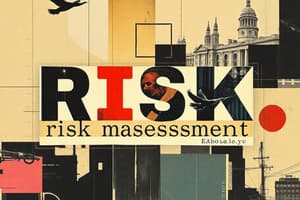Podcast
Questions and Answers
During the Log Phase, growth is rapid, doubling in numbers every few ______.
During the Log Phase, growth is rapid, doubling in numbers every few ______.
minutes
In the Stationary Phase, the number of new bacteria equals the number of organisms that are ______ off.
In the Stationary Phase, the number of new bacteria equals the number of organisms that are ______ off.
dying
Foodborne Illness is transmitted to people by ______.
Foodborne Illness is transmitted to people by ______.
food
Cross Contamination occurs when microorganisms are transferred from one surface or food to ______.
Cross Contamination occurs when microorganisms are transferred from one surface or food to ______.
Infection involves eating a living disease-causing ______ along with food.
Infection involves eating a living disease-causing ______ along with food.
The chance or probability that a person will be harmed or experience an adverse health effect if exposed to a hazard is known as ______.
The chance or probability that a person will be harmed or experience an adverse health effect if exposed to a hazard is known as ______.
Three types of risk include Business, Non-business, and ______ risk.
Three types of risk include Business, Non-business, and ______ risk.
Natural disasters fall under the category of ______ causes of business risk.
Natural disasters fall under the category of ______ causes of business risk.
Potential risks in the hospitality and tourism industry may include safety issues, innovation, natural disasters, and ______ risk.
Potential risks in the hospitality and tourism industry may include safety issues, innovation, natural disasters, and ______ risk.
The practice of identifying potential risks in advance and taking precautionary steps to reduce the risk is known as ______ management.
The practice of identifying potential risks in advance and taking precautionary steps to reduce the risk is known as ______ management.
Microorganisms that can cause illnesses are referred to as ______.
Microorganisms that can cause illnesses are referred to as ______.
The acronym F.A.T.T.O.M. stands for Food, Acidity, Temperature, Time, Oxygen, and ______.
The acronym F.A.T.T.O.M. stands for Food, Acidity, Temperature, Time, Oxygen, and ______.
In the lag phase of bacterial growth, bacteria exhibit life or no growth as they adjust to their ______.
In the lag phase of bacterial growth, bacteria exhibit life or no growth as they adjust to their ______.
Flashcards are hidden until you start studying
Study Notes
Understanding Risk
- Risk is the probability of harm or adverse health effects resulting from exposure to a hazard.
Types of Risk
- Business risk involves factors that can impact profitability or operations.
- Non-business risk refers to risks that are not directly tied to a business environment.
- Financial risk pertains to the possibility of losing money on investments.
Causes of Business Risk
- Natural causes include natural disasters like earthquakes and floods.
- Human causes can involve errors, accidents, or negligence.
- Economic causes are influenced by market elements such as recession or inflation.
Potential Risks in Hospitality and Tourism
- Innovation brings cyber security challenges due to technological advancements.
- Safety issues encompass food safety, slips, falls, and other hazards.
- Natural disasters, including extreme weather and disease outbreaks, are increasing due to climate change.
- Reputational risk centers around online reviews and consumer trust in service quality.
Risk Management
- Risk management is the systematic practice of identifying, analyzing, and mitigating potential risks.
Basic Terminologies
- Hygiene relates to maintaining health through cleanliness.
- Microorganisms are tiny living entities not visible to the naked eye.
- Pathogens are specific microorganisms that can cause diseases.
- Foodborne illness is any sickness caused by consuming contaminated food.
- Foodborne hazards can be biological, physical, or chemical.
Types of Microorganisms
- Beneficial microorganisms play a role in food production.
- Harmful microorganisms spoil food and can lead to disease.
Key Factors of Pathogens in Food
- F - Food
- A - Acidity
- T - Temperature
- T - Time
- O - Oxygen
- M - Moisture
Phases of Bacterial Growth
- Lag Phase: Bacteria adjust to their environment, minimal growth.
- Log Phase: Bacteria reproduce rapidly, doubling in numbers.
- Stationary Phase: New bacterial growth balances with dying bacteria.
- Decline Phase: Nutrient depletion and toxic waste lead to rapid die-off.
General Symptoms of Foodborne Illness
- Headache
- Nausea
- Vomiting
- Dehydration
- Abdominal pain
- Diarrhea
- Fatigue
- Fever
Types of Foodborne Illness
- Infection: Consumption of live, disease-causing microorganisms.
- Intoxication: Results from food poisoning due to toxins.
- Toxin-mediated Infection: Harmful microorganisms produce toxins in the body.
Temperature Control in Food Safety
- Time-temperature abuse occurs when food is kept in the Temperature Danger Zone (40°F - 140°F) for over 4 hours.
Cross Contamination
- Cross contamination happens when microorganisms transfer from one source to another:
- Hand to food
- Food to food
- Equipment to food
Studying That Suits You
Use AI to generate personalized quizzes and flashcards to suit your learning preferences.




